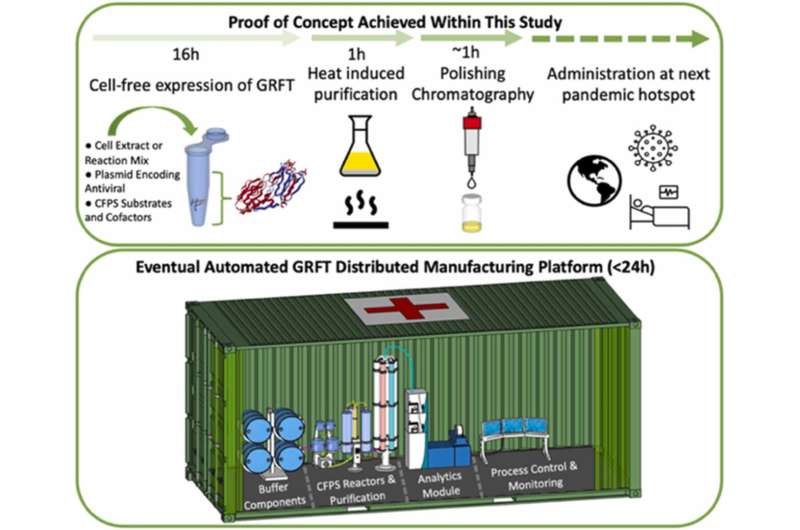This article has been reviewed according to Science X's editorial process and policies. Editors have highlighted the following attributes while ensuring the content's credibility:
fact-checked
peer-reviewed publication
trusted source
proofread
A new way to make a virus-fighting protein could save lives during the next pandemic

A multidisciplinary research team has produced a promising virus-fighting protein using a quick, portable process that could be easily deployed at the source of a future virus outbreak. The team includes researchers from the University of Maryland, Baltimore County (UMBC), Stanford University, the National Cancer Institute (NCI) and the National Center for Advanced Translational Science. Their research has been accepted for publication in the journal New Biotechnology.
Griffithsin is a protein originally isolated from red algae. More than a decade ago, researchers in the Molecular Targets Program of the NCI discovered it could protect cells from the HIV virus, and it is now in Phase 1 clinical trials in humans. Griffithsin sticks to the surface glycoproteins of certain viruses, making it difficult for the virus to enter host cells. (Glycoproteins are proteins with sugar molecules on them.)
"It's like taking clay and sticking it to the prongs of an electrical plug to prevent it from entering a socket," says Govind Rao, a professor of chemical and biochemical engineering at UMBC who is one of the lead researchers on the project. The protein disables a wide range of viruses, including the virus that causes COVID-19.
Medicines that are made with biological molecules like griffithsin are called biologics. They are normally manufactured in huge batches using living cells such as E. coli bacteria. (The cells are given DNA-encoded instructions for how to make the medicine.) However, that method has drawbacks, including the need to keep the cells alive.
Rao and his colleagues developed a method to manufacture griffithsin that does not require living cells. Instead, the researchers take the protein-manufacturing "guts" out of the cells. Into this soup of cellular components, they then add the DNA instructions for making griffithsin, along with the needed molecular building blocks.
"The cellular machinery still works, even without a living cell to support it," says Rao. "The method is simple and effective."
Using cell-free manufacturing methods, the researchers produced significant quantities of griffithsin in less than 24 hours. They purified the protein to strict standards and demonstrated in lab experiments that it could disable both HIV and SARS-CoV-2 viruses as effectively as the same griffithsin protein made by living cells.
The researchers envision that the method could be quickly deployed to make antiviral medicine at the origin of disease outbreaks. The method could be easily adapted to work with a portable, suitcase-sized biologics manufacturing device, dubbed Bio-MOD, that Rao and a team of mostly UMBC researchers recently developed. They described the device in a 2018 paper in the journal Nature Biomedical Engineering.
The new griffithsin protein manufacturing process, together with the portable Bio-MOD device, could be a powerful weapon to quickly combat new viruses before they spread.
More information: Shayan G. Borhani et al, An approach to rapid distributed manufacturing of broad spectrum anti-viral griffithsin using cell-free systems to mitigate pandemics, New Biotechnology (2023). DOI: 10.1016/j.nbt.2023.04.003
Journal information: Nature Biomedical Engineering
Provided by University of Maryland Baltimore County



















